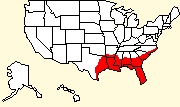|
American Alligator
|
- Order: Crocodylia (alligators and crocodiles)
- Family: Alligatoridae (alligators and
caiman)
- Genus: Alligator (alligators)
|
| Also known as: gator |
Scientific Name: Alligator
mississippiensis (Daudin, 1803) |
| Habitat: swamps,
drainage ditches, wetlands. |
el legarto=Spanish for "the
lizard," mississippiensis="of/from
Mississippi"
|
| Length: to over 19 feet
total. |
|
| Food: About anything
it can overpower and swallow! |
 |
|
This photograph is from the St
Augustine Alligator Farm, which has a couple thousand of these
animals. This individual is doing what alligators do best--lying
motionless in the swamp waiting for prey to come to the water's
edge. I've also seen alligators in more "natural"
settings, including one who surfaced next to me while I was
fishing. |
 |
| Alligators are among the most
vocal of reptiles. At night you can hear their low rumbling
bellows for miles. Gators are in important link in the South's
ecosystem. An alligator will make a "gator hole" by
enlarging and deepening a swampy area to form a suitable-sized
pool. These pools provide homes for all sorts of fish, frogs,
turtles, birds, and mammals. Some of these animals become food for
the gators, but overall the area's biodiversity is greatly
increased by the gator's presence. |
|
| During the last few decades,
alligators have made a tremendous comeback. They were once on the
brink of extinction but through careful management have returned
to most of their historic range to the point of becoming pests in
some areas. |
|
| See also the alligator I
observed in South Carolina. |
|
|
|
|